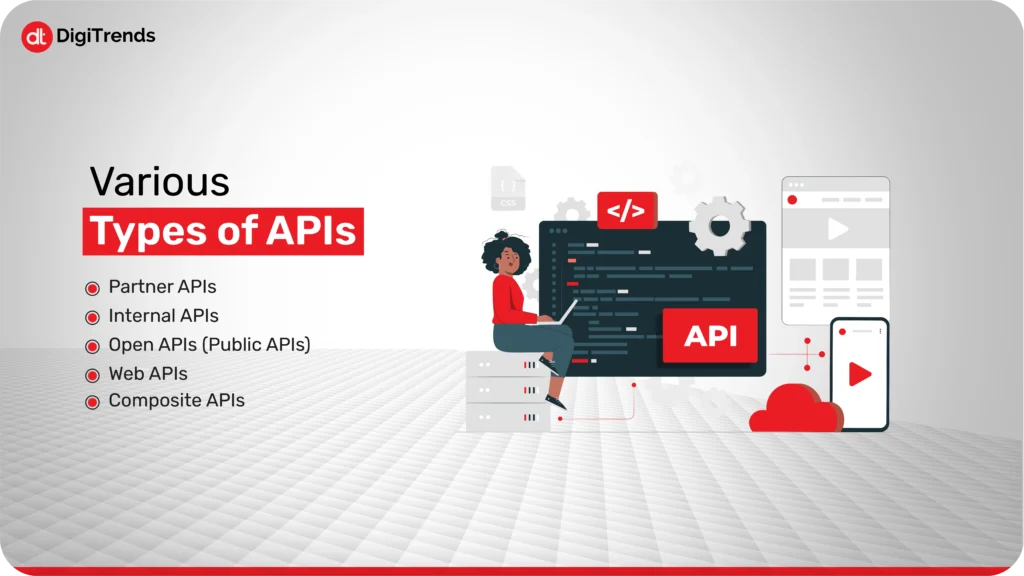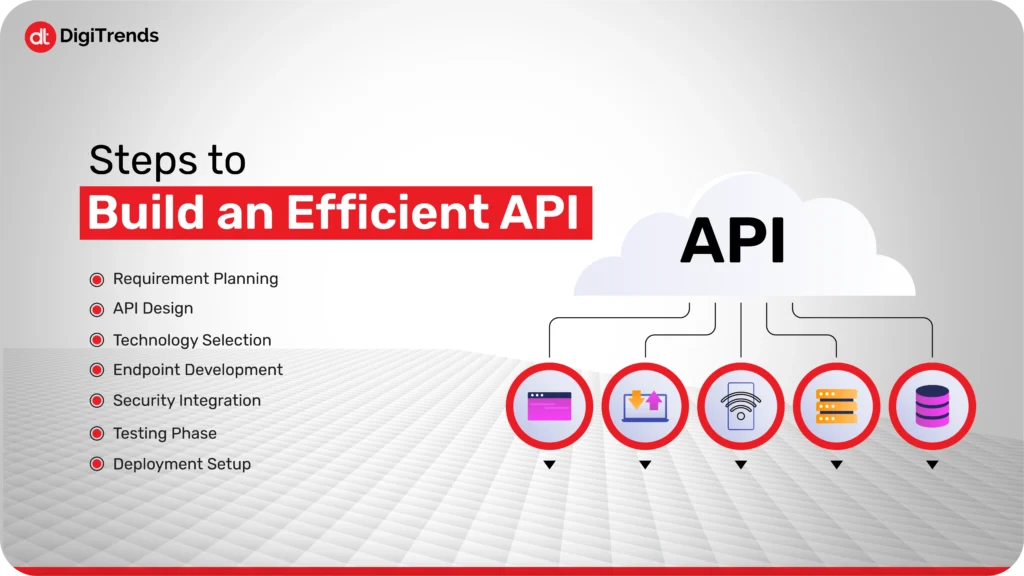Table Of content

In today’s hyper-connected world, APIs (Application Programming Interfaces) are at the heart of nearly every digital product and service. APIs are the core foundations of modern software architecture because they help in enabling seamless communication between software applications and powering integrations across mobile apps, websites, and third-party platforms.
According to Business Research Insights, the API market size is expected to reach 1.67 billion by 2033, which means the demand for scalable and secure API development will increase as we move forward. If you are looking to create a complex cloud-based system or even a simple mobile app, you will need the knowledge of API development before diving into it, because knowing how to develop and manage APIs is a crucial skill for any developer, product manager, or tech entrepreneur.
This blog will provide a complete guide to API development in a clear, approachable way, so even if you are a beginner trying to learn about API development, you don’t need to worry. We’ll explore various types of APIs. You’ll also learn how to set up your development environment, design your first API, test endpoints using tools like Postman, and follow best versioning, documentation, and security practices.
By the end of this blog, you’ll have a solid foundation in API development, along with practical insights and tools to help you start building your APIs confidently.
Let’s get started and unlock the full potential of APIs in 2025 and beyond.
What is an API?
An API is a set of rules and protocols that allow different software systems to communicate and share data. It acts as a bridge between applications, enabling them to interact seamlessly without needing to understand each other’s internal workings.
For example, when we use a weather app, we can see the weather at the exact time from a remote server through an API. Another example of an API is when we use online payment systems for online shopping; it is possible through an API to securely transact the amount. APIs also play a key role in the integration of services such as Google Maps, social media sign-ons, or chatbot capabilities into apps and websites.
Why Learn API Development in 2025?
Modern software is reliant on APIs, which makes the knowledge of API development important. APIs are important in ensuring seamless connectivity, data exchange, and scalability between systems and platforms. Due to this, there is a growing demand for developers who can build, manage, and optimize APIs.
Moreover, learning API development can open up more career opportunities as API is considered to be the backbone of microservices architecture, which is a go-to approach to create modular and maintainable applications. API also allows systems such as the Internet of Things (IoT) and Artificial Intelligence to be merged and operate together.

Various Types of APIs
Understanding the types of APIs will help you choose the right one based on your project’s needs:
1. Partner APIs
Partner APIs serve as the middle ground between public and private APIs. Partner APIs can be shared externally, but under strict rules of authorization. Partner APIs are both free and paid. Some examples of partner APIs are eBay’s API, certain tiers of Twitter’s API (like the Elevated level), and Airbnb’s API.
2. Internal APIs
Internal APIs are also known as private APIs, and these are designed to be used within one organization; they can’t be accessed externally. Internal APIs make sure that the communication and data sharing between internal systems, teams, and services is secure. Companies can use it to manage employee data, finance data, etc.
3. Open APIs (Public APIs)
Open APIs are accessible externally and are typically used for third-party development, to allow external apps and services to interact and operate together. Some examples of open APIs are APIs from social media platforms like Twitter, Facebook, and Instagram.
4. Web APIs
The web APIs are supposed to enable communication with the web servers through the use of the internet, which is typically executed through the use of the HTTP protocol. They allow programs to take inputs and transmit the information on the internet. Some well-known web API include: RESTful API and GraphQL API, which are largely applied in the creation of smart web and mobile applications..
5. Composite APIs
Composite APIs allow requesting multiple API requests as part of one request. This plan is typically used in attempts to enhance various means of implementing the program to enhance performance, reduce network traffic, and also make difficult tasks easier by reducing the number of client-server connections.
How Does an API Work?
APIs facilitate communication between various software systems through a standardized means that enables communication among them. When an application has some data that it requires or an action that it desires, it requests an API, stating what it requires using a fixed set of regulations (generally with the help of HTTP requests such as GET, POST, PUT, or DELETE). The API then processes the request, communicates with the server or database behind the scenes, and sends back a response, often in a format like JSON or XML. This exchange happens in real time and is often invisible to the end user.
Key Features of APIs
If you want to know how to develop an API, then you need to understand the core features of APIs and know why they are such a vital part of modern software development.
Let’s have a look at some key features of efficient and secure API development:
1. Modularity
APIs allow applications to be broken into smaller, manageable services or modules. This modular approach makes development, testing, and scaling much easier.
2. Reusability
Once created, APIs can be reused across multiple projects or platforms. This eliminates redundancy and saves significant development time.
3. Scalability
APIs are designed to handle a growing number of requests without affecting performance. This is especially important for apps that expect high traffic or user load.
4. Standardization
Most APIs follow standardized protocols like REST, HTTP, and JSON, making them easier to understand, integrate, and maintain across various platforms.
5. Security
APIs can include built-in security measures such as authentication (API keys, OAuth), rate limiting, and encryption to protect sensitive data and ensure safe communication.
6. Abstraction
APIs hide the complex logic and internal workings of an application from users and developers, offering only necessary endpoints to interact with.
7. Documentation-Friendly
Good APIs come with clear documentation, often auto-generated using tools like Swagger or Postman, which makes integration and usage easier for other developers.

Steps to Build an Efficient API
Creating a successful API involves more than just writing code. Let’s have a look at the steps required for secure API development:
1. Requirement Planning
Define the purpose of the API, who will use it, and what functionalities it should expose.
2. API Design
Design endpoints, data structures, and response formats. Tools like Swagger or Postman can help with visualization.
3. Technology Selection
Choose the right stack (Node.js, Python, Java, etc.) and framework (Express, Django, Flask).
4. Endpoint Development
Start building your routes and logic that define how data will be retrieved or manipulated.
5. Security Integration
Add authentication (like JWT or OAuth), HTTPS encryption, and role-based access.
6. Testing Phase
Use tools like Postman to test endpoints. Validate input/output and check for edge cases.
7. Deployment Setup
Deploy using cloud services like AWS, Heroku, or Vercel. Set up CI/CD pipelines for continuous updates.
Tools You’ll Need
- Postman – For testing and documenting APIs
- Swagger/OpenAPI – For designing and generating API specs
- Git & GitHub – For version control
- Docker – For containerizing your API
- CI/CD Tools – Jenkins, GitHub Actions, etc. for automated deployments
Best Practices for API Development
- Keep endpoints RESTful and intuitive.
- Version your APIs to maintain backward compatibility.
- Write clean and well-documented code.
- Handle errors with clear and consistent messages.
- Monitor performance and set up logging.
Common Challenges and How to Avoid Them
Even though APIs can significantly simplify development and integration, there are common pitfalls that developers, especially beginners, should be aware of.
Here’s a closer look at some of the challenges in custom API development and how to effectively avoid them:
1. Poor Documentation
APIs are only as good as their documentation. Without clear, accurate, and up-to-date documentation, other developers will struggle to understand how to use your API properly. This can lead to misuse, errors, and increased support requests.
How to avoid it: Use tools like Swagger (OpenAPI) or Postman to automatically generate interactive, user-friendly documentation as you develop. This ensures consistency and helps other developers easily test and understand your endpoints.
2. Overexposure
Leaving your API fully open or lacking proper access control can lead to security vulnerabilities, abuse, or performance issues. Hackers and bots may exploit public endpoints, causing data leaks or system overload.
How to avoid it: Implement authentication methods such as API keys, OAuth2, or JWT. Also, use rate limiting and IP whitelisting to restrict how often and by whom your API can be accessed.
3. Inconsistent Data Structures
Inconsistencies in request and response formats can confuse users and increase the risk of bugs and integration issues. For instance, returning different data formats from similar endpoints makes client-side development harder.
How to avoid it: Adopt and stick to standardized formats like JSON: API for REST or well-defined GraphQL schemas. Maintain consistency in naming conventions, status codes, error responses, and data organization.
4. Ignoring Scalability
APIs that work fine with a few users might fail under heavy load if scalability is ignored. Without performance planning, APIs can become slow, unresponsive, or crash entirely.
How to avoid it: Use caching (like Redis or in-memory stores) to avoid repeated database hits, implement pagination for large data sets, and consider load balancing to distribute traffic across multiple servers or containers efficiently.
API Development Cost Breakdown
The cost of developing an API in 2025 can vary significantly depending on the complexity, features, security requirements, and the development approach you choose. Whether you’re hiring a freelance developer, building in-house, or outsourcing to an agency, understanding the cost breakdown helps in planning effectively.
| API Type | Estimated Cost (USD) | Description |
| Basic API | $1,000 – $5,000 | CRUD operations, a few endpoints, minimal security, and no third-party integration |
| Mid-Level API | $5,000 – $15,000 | Authentication, user roles, external service integration, and better security |
| Advanced API | $15,000 – $50,000 | High scalability, OAuth 2.0, rate limiting, versioning, third-party integrations |
| Enterprise-Level API | $50,000 – $100,000 + | Compliance (GDPR, HIPAA), microservices, CI/CD, extensive documentation, monitoring |
While actual pricing can vary depending on the scope and complexity of your project, most custom API development costs in 2025 range between $1,000 and $100,000+. The final budget depends on factors like the number of endpoints, security layers, third-party integrations, and documentation needs.
Partnering with an experienced development team like DigiTrends can help you get high-quality, scalable APIs that fit your business goals and budget. With the right planning and execution, your API investment can deliver long-term value and set a strong foundation for future growth.
Factors That Influence API Development Cost
1. Number of Endpoints:
More endpoints mean more development and testing time.
2. Security Requirements:
Advanced authentication, data encryption, and threat prevention add to development costs.
3. Tech Stack & Infrastructure:
The choice of backend language, cloud hosting, and database setup can impact both time and expense.
4. Documentation & Testing:
Thorough documentation and automated testing are critical, but they also require extra effort.
5. Team Location:
Hiring developers from North America or Europe may cost more than outsourcing to regions like South Asia or Eastern Europe.
Cost-Saving Tips for API Development:
- Start with an MVP (Minimal Viable Product) API to validate your idea before scaling.
- Use open-source frameworks and libraries to reduce development time.
- Consider using API management platforms like Postman, SwaggerHub, or RapidAPI to speed up development and reduce costs on documentation and testing.
Conclusion
APIs have become an essential part of modern software development, acting as the glue that connects systems, services, and users in today’s digital ecosystem. Whether you’re building a mobile app, a web app, or integrating third-party services, having a well-designed API is key to performance, scalability, and user satisfaction.
This beginner’s guide has covered everything from the types of APIs and how they work to the common challenges, cost considerations in 2025, and a step-by-step custom API development process. By following best practices and choosing the right tools and technologies, you can create APIs that are efficient, secure, and developer-friendly.
If you’re looking to bring your API vision to life, DigiTrends offers expert development services tailored to your business needs. With a team experienced in building high-performance APIs across industries.






